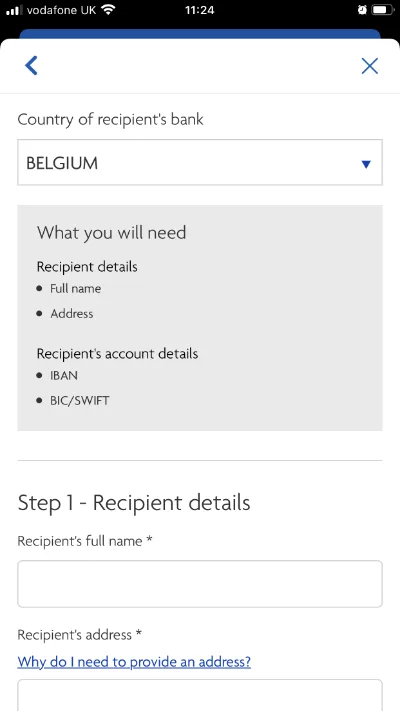
With growing competition, the best ways to transfer money overseas from a bank account may no longer be through your bank. Other traditional options, like sending cash, a cheque or even a money order are also outdated – and risky. Many money transfer services will offer a better rate than your bank, all from the convenience of your home. Discover how to transfer money internationally for less, sometimes in as little as a few minutes.
How can I transfer money internationally between banks?
There are three main ways to transfer money overseas from a bank account, and some of them offer additional options like delivery for cash pickup:
- Set up a new recipient in your online/mobile banking arrange the transfer yourself. If you don’t mind the potentially high fees (which may be hidden in a poor exchange rate), this is likely to be the easiest – but not necessarily fastest – option.
Global transfers through your bank - Use a specialist money transfer service. Services dedicated to sending money internationally can usually beat the rates and fees offered by your bank (and often the transfer speeds too). You transfer the money to their UK account and give them your recipient’s details, and they take care of the rest. Some of these services (e.g. Western Union) can arrange cash pick-ups in the local currency.
Discover and compare transfer services - Go to your nearest branch and arrange the transfer in person. Physically going to the bank to send your money internationally may be the least convenient option, but you may appreciate having a human steering you through the process. As with using arranging the transfer entirely yourself through your internet/mobile banking, it’s unlikely to be the option representing the best value, as banks tend to charge high fees or give poor exchange rates when it comes to international transfers.
Global transfers at a bank branch
Making an international money transfer online from your bank
- Pro: This is perhaps the easist way to arrange your transfer.
- Con: You’ll often lose money on fees and/or poor exchange rates.

If you’re set-up for online banking or use your bank’s app for most of your day-to-day banking needs, you can follow these steps to arrange your international bank transfer (note that the steps will vary slightly from bank to bank):
- Sign in to your online banking or mobile app. Visit your bank’s site and look for the log-in button, or simply launch the mobile app and verify yourself.
- Go to the account you wish to transfer from and select “Pay/Transfer”. The exact wording will vary from bank to bank, so look out for “Payments and transfers”, “International transfers” or similar.
- Create a new payee. At this point you’ll usually be able to select “International bank account” or similar. You’ll need to provide their full name, address (for anti-fraud purposes), IBAN (International Bank Account Number) and BIC/SWIFT (Bank Identification Code) number. Some countries may require slightly different details, but those are the most common. Your recipient may need to go to their own online banking to get these numbers for you.
- Enter sending amount and desired currency. At this point your bank should give you an indication of how much your transfer will cost (or how much your recipient is going to receive). You should be able to see what fees are being applied and what exchange rate is being used. Banks often place limits on outgoing money transfers, so confirm that your bank’s limit is high enough for your transfer. When you need to send more than the limit, consider using a money transfer service instead.
- Action the transfer. If you’re happy to proceed, you can go ahead and press send. Your bank may ask you to enter a passcode again at this point, since you’re sending to somebody new.
- Wait for your transfer to arrive. International money transfers can take anywhere from a few business days to over a week, depending on how many banks the money has to move through to get to its destination. Check with your bank to find out the status of your transfer. Note that your recipient’s bank may charge an incoming transfer fee as well.
Using an online money transfer service
- Pro: Save money by using a specialist service with bank-beating rates and fees.
- Con: You’ll need to create an account with a new service, which is a minor hassle.
There’s a lot of competition between online money transfer services – which should benefit you while looking for the best deal. The majority of providers will allow you to transfer money from one bank to another, and many of them have additional sending options.
Finder survey: What aspects of an international money transfer service matter most to Brits when choosing one?
31% of people who would use a money transfer service said exchange rate was the most important aspect in choosing a brand.
| Response | |
|---|---|
| Exchange rate | 31.3% |
| Fees/commission | 29.13% |
| Don't know | 24.2% |
| Security | 24.2% |
| Speed of transfer | 23.48% |
| Range of payment methods | 14.78% |
| Customer service | 14.06% |
| Overall amount recipient gets | 13.77% |
| Provider reputation | 12.32% |
| Range of pick-up methods | 12.03% |
More online services to help you transfer money overseas from a bank account
Other notable mentions to help you move your money internationally include:
- TorFX – TorFX is great if you’re sending several thousand pounds, because you’ll get a dedicated account handler to guide you through the process – oftern guaranteeing rates or helping you to set rate targets.
- OFX – If you need to send or receive in an uncommon currency, OFX supports a wide range of coins – but it’s only online.
- Remitly – This transfer service boasts speed across its network, but its low maximum limits may not work for everyone.
- Western Union – Brand awareness and a massive network of physical branches (great for cash pick-ups) might suit some, but watch out for the fees.
Sending an international money transfer in person at your bank
- Pro: In-person assistance to complete your transfer at your bank.
- Con: Restricted to sending during banking hours while often paying higher in-person fees.
If you like to keep your business in-person, you can head to your bank to send an international money transfer through a cashier.
Be sure to bring:
- Name and address of your recipient’s bank
- Recipient’s name and full address
- Recipient’s account number or international bank account number (IBAN)
- Recipient’s SWIFT or BIC code, which can be found by asking the recipient’s bank
- Proof of ID
The steps for sending an international money transfer in person from your bank are similar to those for sending online:
- Start your transaction: Ask the teller to start an international money transfer.
- Prove your identity: Provide documents and identification.
- Double-check details: Confirm details with the teller, double-check everything before sending.
- Pay: Pay for your transfer using cash or your bank account balance.
- Get proof: Get a receipt and keep it somewhere safe.
Some banks charge more for in-person money transfers than they would for online money transfers, so make sure you ask the teller if you could save money by making the transfer online instead of in person.
Bottom line
While there are different methods for transferring money overseas from your financial institution, the cheapest is likely to be a speciallist money transfer service. To get the best deal, be aware of rates, fees and transfer speeds. Though it can be convenient to transfer money overseas direct from your online banking, comparing your options will almost always mean you’ll save money on your transfer (or be able to send more to your recipient!).
More guides on Finder
-
4 ways to streamline your international business payments with WorldFirst
As more businesses plan to go global, find out how WorldFirst’s multi-currency account could benefit your operations. Paid content.
-
Alternatives to Small World
Learn about how Small World alternatives can help you send more money for less.
-
Tax guidelines and regulations for large money transfers into the UK
Learn about taxes on large-money transfers to the UK from abroad, including penalties and exceptions.
-
Xe money transfer calculator and review
Xe is a leading company of currency solutions that offers competitive exchange rates, no fees and fast money transfers.
-
Lloyds Bank international transfer calculator and review
Lloyds Bank provides a range of options for sending money overseas to friends and family. See exchange rates, fees and services here and compare your options.
-
Guide to bank fees for wire transfers
Wire transfers can sometimes incur fees, but comparing your options could help you avoid these.
-
TorFX money transfer review
Check out our review of TorFX’s fee-free money transfers.
-
Wise review
Read our Wise review to see the exchange rates, fees and what to expect when you send a transfer.
-
Western Union review
If you’re thinking of sending a money transfer with Western Union, read our review of its transfer speed, exchange rates and fees first.
-
International money transfers with cash pickups
Send an international money transfer to someone without a bank account. Get it there instantly and they can pick it up in person, in cash. Get quotes now.

